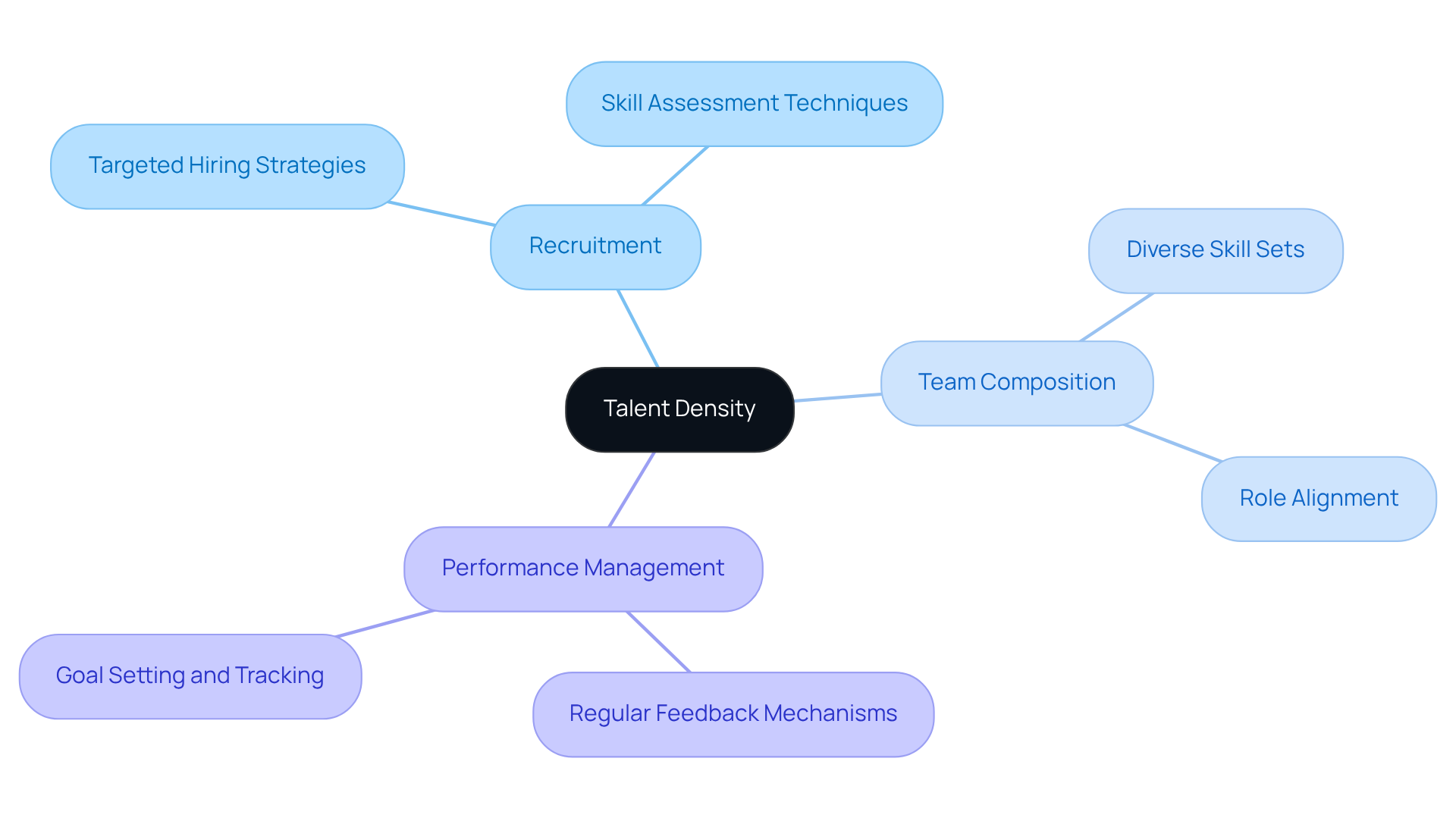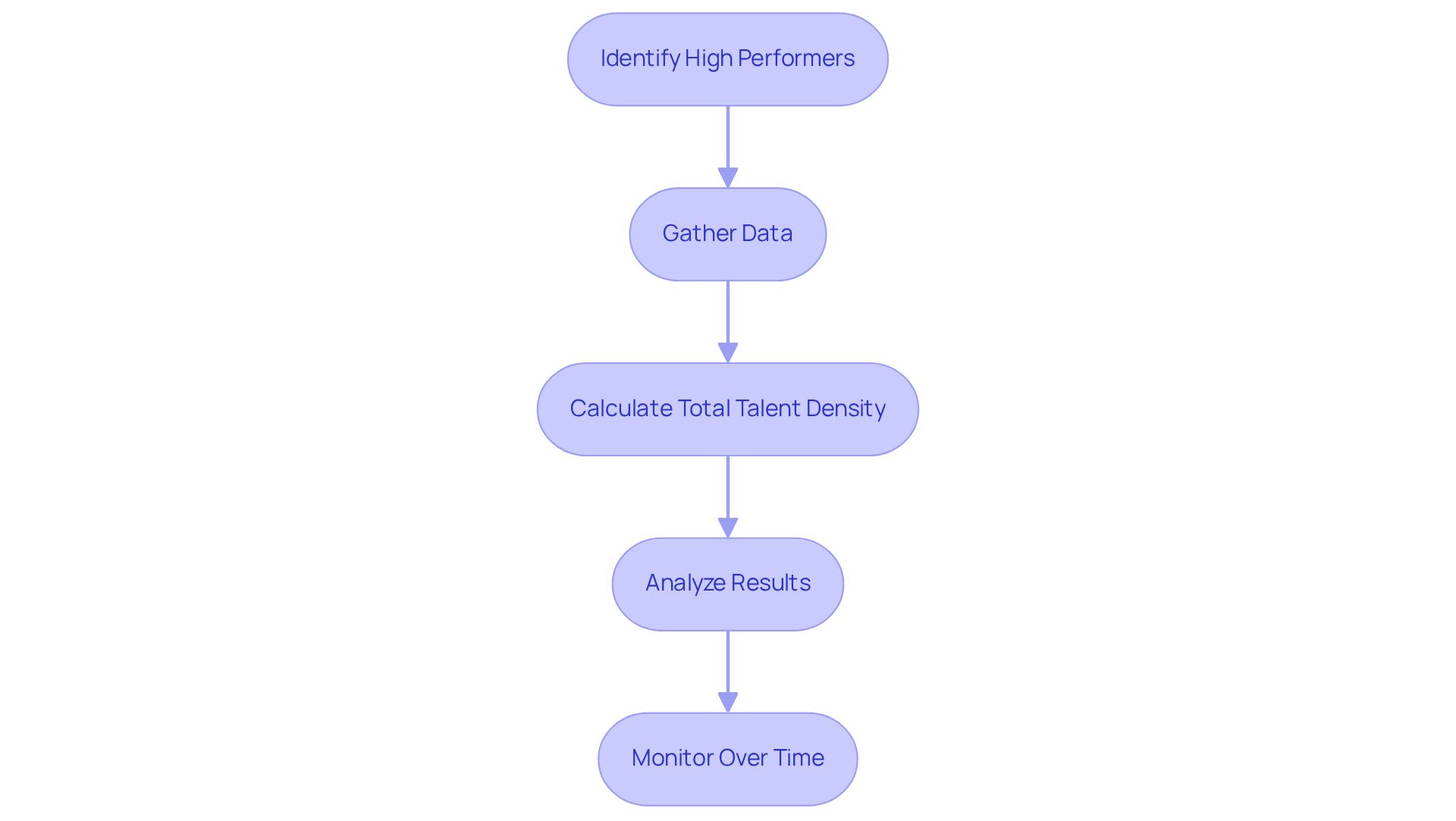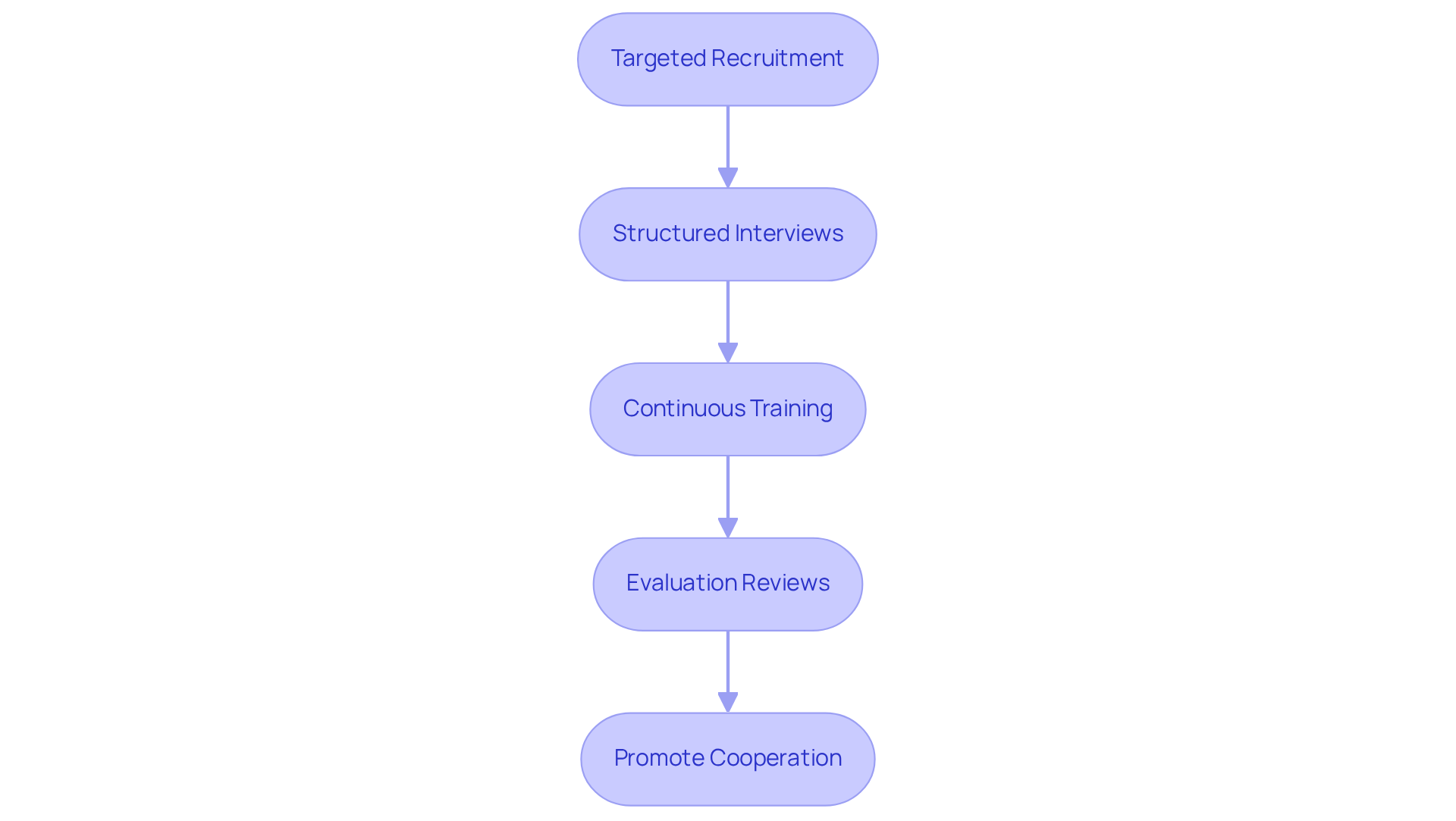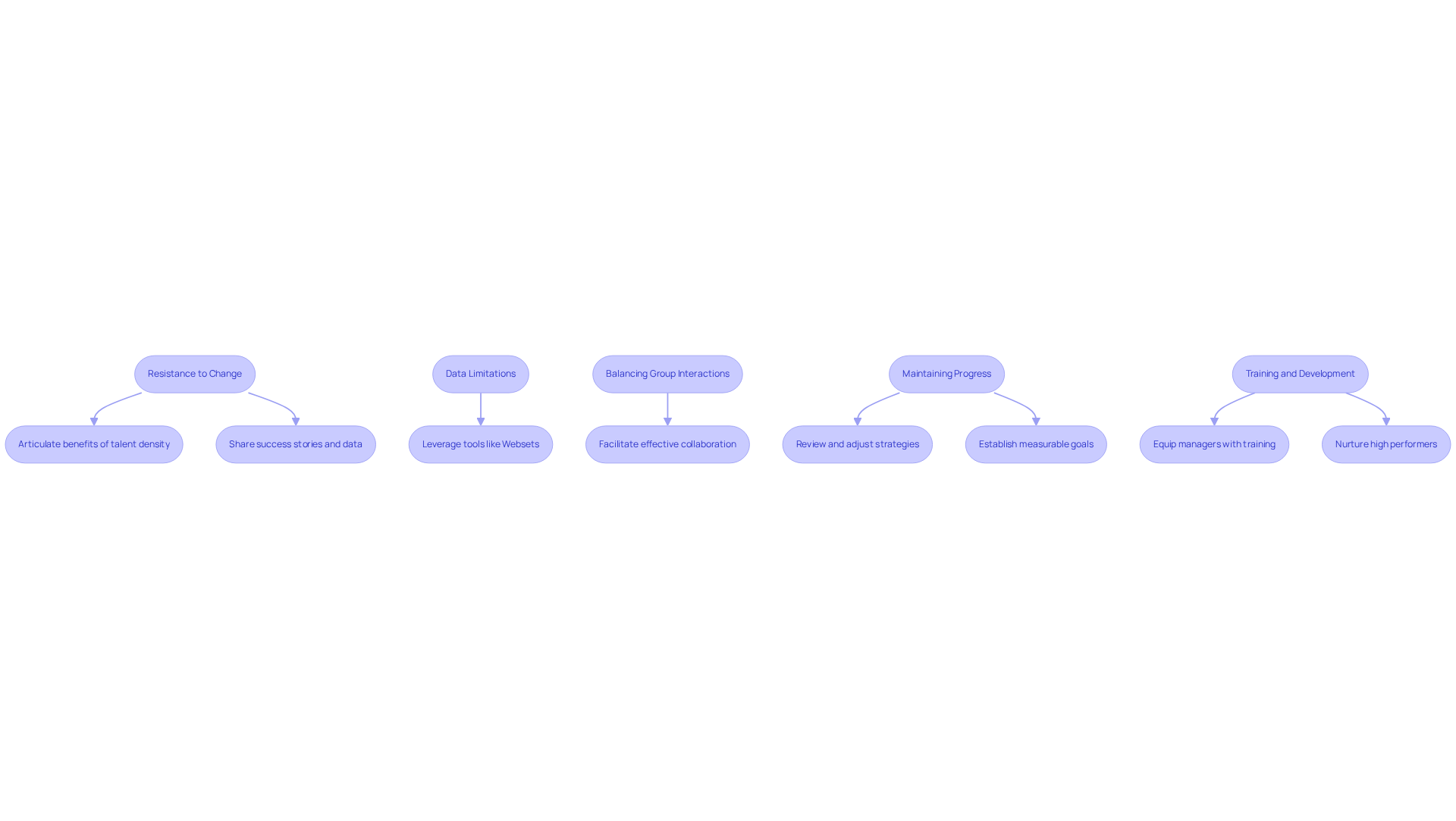Overview
This article highlights the pivotal role of mastering talent density as an investment metric that can propel sales success by concentrating high-performing individuals within a team. Organizations boasting higher talent density are not only better positioned to adapt to market fluctuations but are also primed for sustainable growth. This assertion is backed by effective strategies in recruitment, performance management, and continuous training aimed at optimizing team effectiveness. By focusing on these elements, businesses can create a robust framework that enhances their adaptability and overall performance.
Introduction
In the competitive landscape of sales, talent density emerges as a pivotal factor that dictates an organization's success. This crucial metric, representing the concentration of high-performing individuals within a team, unlocks enhanced collaboration, creativity, and overall efficiency. As businesses strive for sustainable growth and adaptability in fluctuating markets, the challenge lies in effectively measuring and optimizing talent density.
How can organizations harness this powerful investment metric to elevate their sales performance while refining their recruitment strategies and team dynamics?
Define Talent Density and Its Importance in Business Growth
Talent concentration signifies the assembly of high-performing individuals within a team or organization. This metric, referred to as talent density as an investment metric, is crucial; a greater concentration of skills often leads to improved teamwork, creativity, and efficiency. In the sales arena, where outcomes are paramount, understanding and enhancing skill concentration can significantly impact revenue generation.
Organizations boasting a high concentration of skilled individuals are better positioned to adapt to market fluctuations, increase sales, and achieve sustainable growth. By focusing on talent density as an investment metric, organizations can make informed decisions regarding:
- Recruitment
- Team composition
- Performance management
Ultimately, this approach bolsters their competitive edge in the marketplace.

Calculate Talent Density: Steps and Metrics to Consider
To calculate talent density, follow these essential steps:
-
Identify High Performers: Clearly define what constitutes a high performer in your organization. This could be based on sales figures, customer feedback, or other relevant metrics that highlight excellence.
-
Gather Data: Collect comprehensive information on your sales group, including performance metrics, roles, and contributions. This data is crucial for an accurate analysis.
-
Calculate Total Talent Density: Apply the following formula:
Talent Density = (Number of High Performers) / (Total Number of Team Members)
For instance, if your team comprises 10 high performers out of 20 members, your talent density would be 0.5, or 50%.
-
Analyze Results: Compare your skill concentration against industry standards to assess your competitive position. A higher percentage signifies a more robust group capable of driving sales effectively, highlighting the importance of talent density as an investment metric.
-
Monitor Over Time: Regularly reevaluate skill levels to track improvements or declines. Adjust your hiring and training strategies accordingly to ensure continuous growth and development.

Utilize Talent Density to Optimize Recruitment and Team Performance
To effectively leverage talent density for optimizing recruitment and team performance, consider implementing the following strategies:
-
Targeted Recruitment: Prioritize attracting candidates who not only meet the necessary skill requirements but also align with the high-performance profile established within your organization. This approach ensures that new hires contribute positively to the overall talent density. By utilizing Websets' precision-driven B2B lead generation capabilities, you can find companies and individuals that fit hyper-specific criteria, ensuring clarity in recruitment.
-
Structured Interviews: Employ structured interviews enhanced by AI-driven strategies to evaluate candidates against the specific traits and behaviors exhibited by your top performers. This method significantly enhances the likelihood of selecting individuals who will excel in your group setting.
-
Continuous Training: Invest in ongoing training and development programs aimed at enhancing the skills of current personnel. By improving their abilities, you increase the overall skill density, which can lead to better group outcomes. Continuous development is crucial in maintaining a competitive edge, especially considering that 60% of employers are concerned about unfilled job positions.
-
Evaluation Reviews: Conduct regular evaluation reviews to identify potential high achievers within your team. Providing these individuals with growth opportunities not only boosts their engagement but also strengthens the overall talent pool. Effective onboarding and evaluation of employees can significantly enhance retention rates.
-
Promote Cooperation: Encourage partnership among group members to facilitate the sharing of best practices and strategies. This collaborative effort can improve overall output and contribute to a greater skill concentration within the group.
By concentrating on these strategies, organizations can establish a robust framework for optimizing recruitment and enhancing group performance through heightened skill concentration. Utilize advanced AI-driven recruitment methods to source candidates with distinctive qualities.

Overcome Challenges in Implementing Talent Density Strategies
Overcoming obstacles in skill concentration requires strategic approaches. Consider these effective strategies:
- Resistance to Change: Articulate the benefits of focusing on talent density to your team. Share compelling success stories and data that illustrate how talent density as an investment metric positively impacts sales outcomes.
- Data Limitations: Access to accurate and comprehensive information on team performance is crucial. Leverage tools like Websets to enrich your data, enabling deeper insights into your team's capabilities and potential.
- Balancing Group Interactions: While enhancing skill concentration is vital, it’s essential to consider group dynamics. Facilitate effective collaboration among high performers and their peers to sustain a positive team atmosphere.
- Maintaining Progress: Regularly review and adjust your workforce strategies to ensure they remain relevant. Establish measurable goals and track progress consistently to keep focus and motivation high.
- Training and Development: Equip managers and team leaders with the necessary training to identify and nurture high performers, ensuring the effective implementation of talent density strategies.

Conclusion
Talent density stands as a crucial investment metric that can dramatically elevate sales success. By understanding and optimizing the concentration of high-performing individuals within a team, organizations can drive enhanced performance, creativity, and adaptability in a competitive marketplace. Prioritizing talent density not only informs recruitment and team composition but also fortifies overall performance management, ultimately fostering sustainable business growth.
This article delineates the essential steps to calculate talent density, underscoring the importance of identifying high performers and gathering comprehensive data. By applying the talent density formula and analyzing results against industry benchmarks, organizations can assess their competitive positioning. Moreover, strategies such as:
- Targeted recruitment
- Structured interviews
- Continuous training
emerge as effective methods for optimizing team performance and cultivating a collaborative environment that enhances skill concentration.
Reflecting on the significance of talent density, it becomes evident that organizations must prioritize this metric to thrive in today’s dynamic business landscape. By overcoming challenges related to data limitations and resistance to change, companies can harness the power of talent density to not only enhance sales outcomes but also build a resilient workforce. Embracing these strategies is essential for any organization aiming for excellence and striving to maintain a competitive edge in their industry.
Frequently Asked Questions
What is talent density?
Talent density refers to the concentration of high-performing individuals within a team or organization. It is a metric that indicates how many skilled individuals are present in a given area.
Why is talent density important for business growth?
Talent density is important because a greater concentration of skills leads to improved teamwork, creativity, and efficiency. Organizations with high talent density are better equipped to adapt to market changes, increase sales, and achieve sustainable growth.
How does talent density impact revenue generation in sales?
In the sales arena, understanding and enhancing skill concentration can significantly impact revenue generation, as a high concentration of skilled individuals can lead to better performance and results.
How can organizations utilize talent density as an investment metric?
Organizations can use talent density to make informed decisions regarding recruitment, team composition, and performance management, ultimately strengthening their competitive edge in the marketplace.




